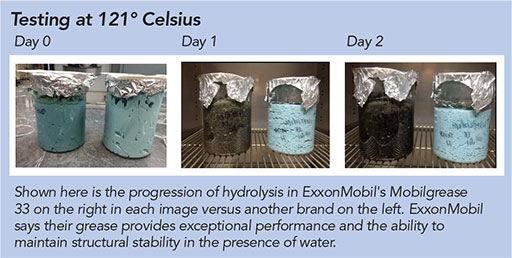Airlines are operating at lower cost margins than ever before, meaning a single misstep or grounding of an aircraft can potentially result in missed revenue targets. The cost of flight delays in the U. S. is estimated to be as much as $31 million annually, according to Airlines for America. As a result, technicians have to follow rigorous precautionary measures to ensure aircraft are operating efficiently.
Using the right lubrication paired with the proper storage and handling techniques can have a crucial impact on preserving component condition and enhancing aircraft reliability. This is especially true for greases, which play a pivotal role in protecting flight controls, landing gear systems, bearing assemblies and ground support equipment under a variety of operating environments.
Under extreme environments, grease formulations can be exposed to a greater risk of contamination. One example is water exposure, which can cause grease to undergo hydrolysis, a chemical reaction that can cause a grease’s base oil and/or additives to break down. When hydrolyzed, the grease’s ability to protect critical aircraft components may be negatively impacted.
Warning Signs of Hydrolysis
Hydrolysis can occur when grease is exposed to excessive water such as precipitation and de-icing fluids on the tarmac, or when it’s stored improperly.
Diagnosing hydrolyzed grease is not an exact science, but the following observations can indicate that grease has been compromised (see images):
- Unusual color: When compared to fresh grease, hydrolyzed grease may appear darker, or even black, as seen in the images.
- Abnormal consistency: Hydrolysis can alter a grease’s consistency, making it appear softer or stiffer than usual.
- Strong, unpleasant odor: At times, a hydrolyzed grease can give off a distinct odor which is not consistent with a fresh sample.
Hydrolysis may occur immediately after a grease is exposed to water, and the rate is typically impacted by the severity of an application’s operating temperatures and exposure to certain elements. However, hydrolyzed greases may show few-to-none of these warning signs throughout a grease’s lifecycle. To be safe, technicians should evaluate their grease every 10,000 hours for irregularities and consult their suppliers with any questions.
Reducing the Rate of Hydrolysis
Although a serious condition, hydrolysis is preventable. With this in mind, here are three tips and strategies to help prevent grease from hydrolyzing.
First, choose the right grease formulation. There are a number of grease characteristics to evaluate to help keep the rate of hydrolysis to a minimum. It’s important for grease to contain a hydrocarbon base oil, which serves as the backbone of product performance. Hydrocarbon-based greases are less susceptible to hydrolysis.
To protect against hydrolysis, greases should also contain additive technology that provides excellent water resistance. This helps prevent contamination and degradation when exposed to adverse weather and wet conditions.
In addition to water resistance, grease should be well-equipped with robust oxidation and rust inhibitors, extreme pressure additives, and anti-wear and friction-reducing agents that can help further enhance performance in adverse conditions involving exposure to water.
Next, grease must be properly stored and handled. Selecting the right grease is not enough. To preserve grease for the duration of its shelf life, it must be stored properly.
To preserve shelf life, greases should be stored in dry, clean environments between 0º and 40º Celsius. In the event that a stored grease is briefly exposed to severe temperatures or environmental conditions, technicians should consult their suppliers with concerns.

Once a grease package is opened, the grease should be used as soon as possible. In addition, if improperly stored, the grease may become contaminated and it will likely deteriorate. As a result, the grease will need to be disposed.
And lastly, don’t be afraid to consult your supplier. Fortunately, a number of regulations and maintenance checks are already in place to prevent hydrolysis from affecting aircraft components. However, if signs of hydrolysis start to appear, technicians should contact their supplier immediately.
Suppliers can help evaluate grease programs help technicians analyze their aircraft as well as OEM recommendations to identify the best possible mix of greases and oils for their fleets.
Suppliers can conduct lubricant storage and handling studies and provide analysis, assessments and recommendations regarding product storage and handling conditions. Learn more at https://www.exxonmobil.com/en/aviation.
